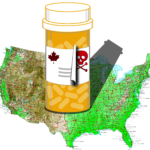Canadian Drug Imports Stall
In late 2020, the Department of Health and Human Services (HHS) approved federal rulemaking for state importation programs (SIPs), which the Food and Drug Administration (FDA) would use to approve state-based wholesale Canadian drug importation programs.
Canadian drug importation has been a legal possibility since the Medicare Modernization Act (MMA) was enacted in 2003—but the law requires that imported medicines come from Canada’s drug supply, that they introduce no additional risk, and that they deliver substantial savings to the public. Until 2020, no FDA or Health and Human Services head felt importation met the MMA’s requirements, in large part because the necessary medicine-safety testing requirements spelled out in the MMA make substantial savings all but impossible.
Watch our video for a two minute status update for the six states that have passed laws legalizing state importation programs.
See the latest importation news
 at the Federal and state levels: Colorado, Connecticut, Florida, Maine, New Hampshire, New Mexico, Vermont
at the Federal and state levels: Colorado, Connecticut, Florida, Maine, New Hampshire, New Mexico, Vermont
Nothing really changed in 2020 to make importation suddenly more workable. The administration pressed forward with these rules over the recommendations of four previous FDA commissioners, regulators, pharmacist organizations, the pharmaceutical supply chain, and the Canadian government. The rulemaking did, however, green-light the efforts of Vermont, New Hampshire, New Mexico, Maine, Florida and Colorado to move on with the SIPs they were already pursuing.
As of March 2021, despite a great deal of forward-planning on the part of the states, none of these programs is in place. Here’s a status update.
Vermont
The Governor of Vermont signed S 175, which directed the Agency of Human Services (VAHS) to design a program for wholesale Canadian prescription drug importation, in May 2018. Seven month later, VAHS reported to the state legislature that they couldn’t recommend an importation program until they understood operating costs better.
In October 2019, the governor submitted a concept plan to HHS for further guidance. The state does not seem to have made any progress since then.
New Hampshire
New Hampshire’s drug importation law, which was enacted in July 2020, stated that the state would submit a plan to HHS by February 1, 2021.
New Mexico
In March 2020, New Mexico’s governor signed SB1, a bill to create a wholesale prescription drug importation program administered by New Mexico's Department of Health.
On November 27, 2020, two weeks before New Mexico published the final version of its plan, Canada announced an “Interim Order Respecting Drug Shortages,” which banned the export of any medicine that might cause or exacerbate drug shortages for its citizens.
Maine
Maine signed LD1272 into law in June 2019 and submitted an application to the federal government in April 2020. A year later, we’ve heard nothing.
Through a FOIA request, however, PSM acquired a price comparison which showed that after factoring in rebates and discounts, Maine’s Medicaid program receives many medications at lower prices than the Canadians do. In fact, the state would pay nearly nearly a million dollars more for the Canadian drugs they studied.
Florida
Florida enacted its importation bill, SB19, in June 2019 and followed it up with a concept paper that they submitted to HHS the next month. In it, they named potential Canadian suppliers who stated publicly that they had no intention of participating.
After failing to find companies willing to bid on the three-year, $30 million dollar contact to run the program by a September 30, 2020 deadline, Florida submitted an application with a logistics provider but no Canadian supplier to HHS in November 2020.
Colorado
Colorado’s SB19-005, signed into law in May 2019, created a "Canadian Prescription Drug Importation Program" in the Department of Health Care Policy and Financing (CHCPF). As Colorado put together its plan, though, it became clear that creating a safe, inexpensive, legal importation program was harder than it seemed.
In its March 2020 application draft, CHCPF sought safety shortcuts that violate federal law, allowing medicine from other countries and imported biologics so that it could ”realize significant savings for consumers.” The agency also acknowledged that the state’s Medicaid program had such deep drug discounts that importation wouldn’t save patients any money.
In our own analysis, PSM found that a third of the brand name drugs listed in the March 2020 draft were available as U.S. generics. We estimated that Colorado could save more than $43 million, without sinking money into a drug importation program, simply by using existing generic medicines.
Colorado continues to press forward, burning hundreds of thousands of dollars out of the two million assigned to this project. The state released an Invitation to Negotiate seeking a vendor to run a state importation program in January 2021.
Seek Real Solutions
In the final analysis, all these well-intentioned proposals are a waste of time and money. The Canadian government can’t supply the U.S. and has blocked the export of any prescription medicine that would cause or worsen a drug shortage in Canada.
Furthermore, the future of federal regulations around state importation programs is uncertain. PSM is among several groups who are suing to overturn them in federal court because we are deeply concerned about whether SIPs can be carried out safely.
There are safe ways to reduce pharmaceutical costs: regulating pharmacy benefit managers and bolstering the use of generic drugs are examples that have proven success. We must stop talking about ideas that haven’t worked for twenty years and start focusing on ones that do.